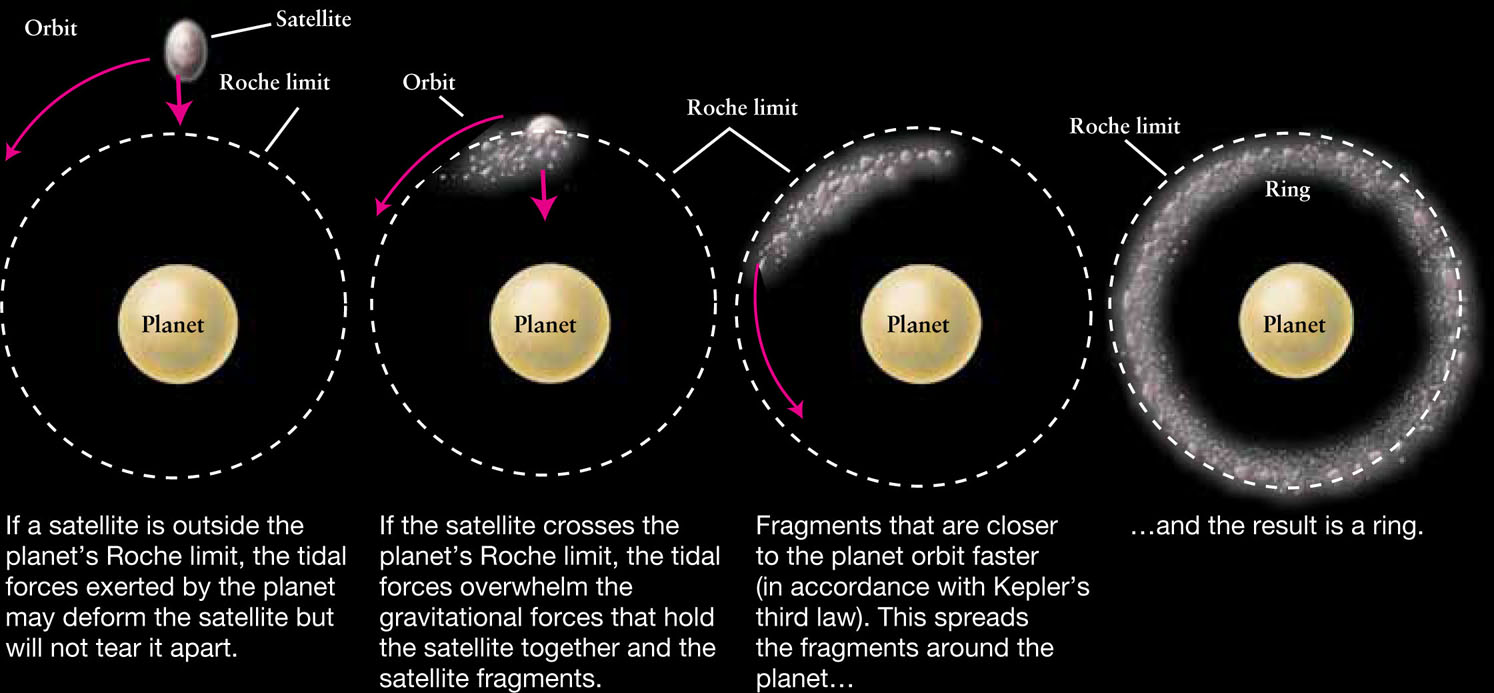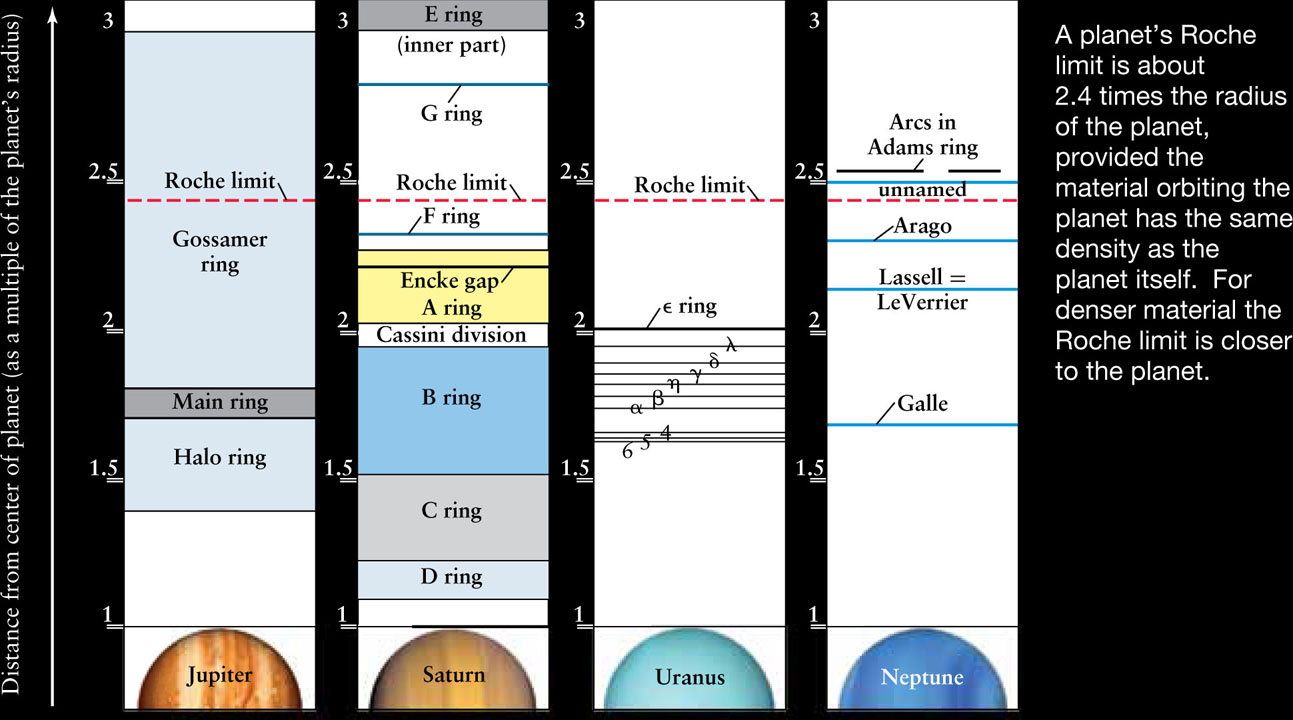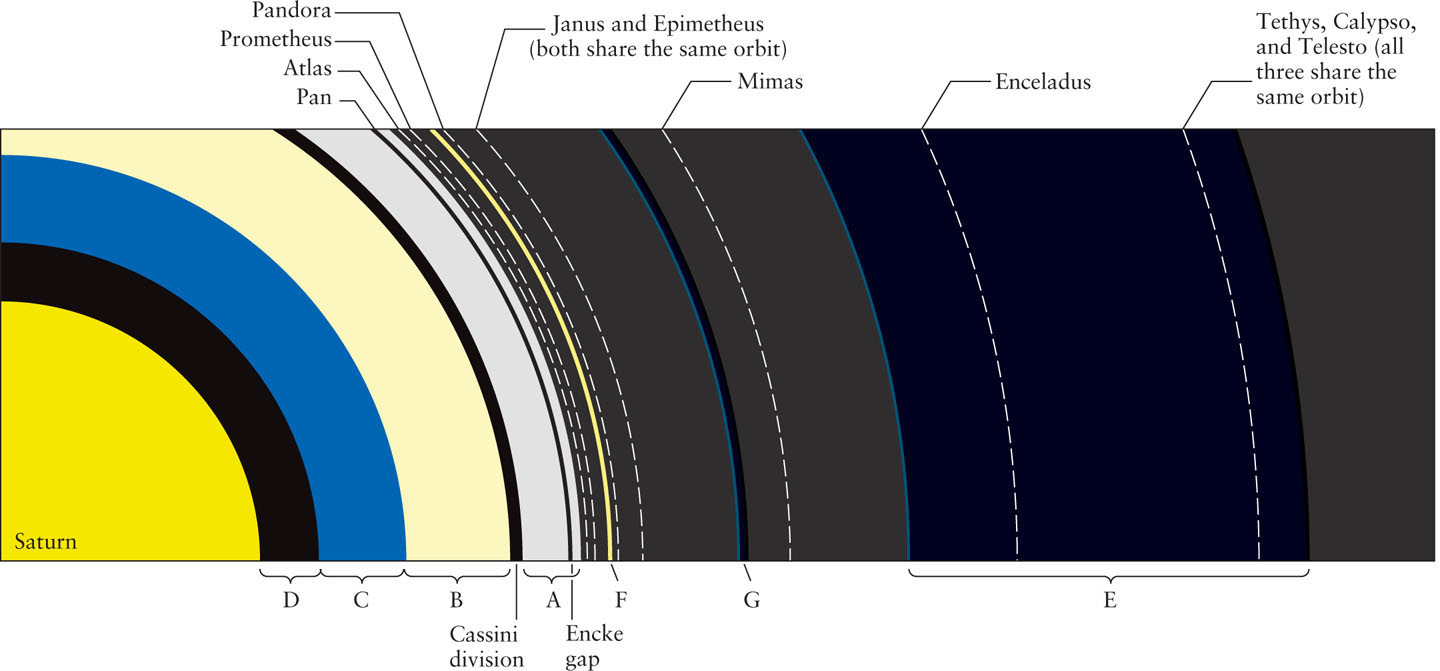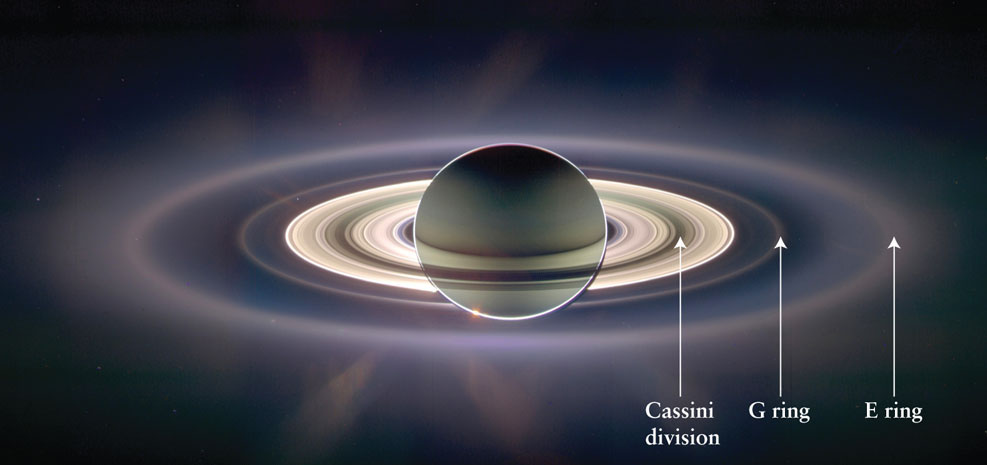12-10 Saturn’s rings consist of thousands of narrow, closely spaced ringlets
The photograph in Figure 12-1b, which was made in 1974, indicates what astronomers understood about the structure of Saturn’s rings in the mid-1970s. Each of the A, B, and C rings appeared to be rather uniform, with little or no evidence of any internal structure. Within a few years, however, close-up observations from spacecraft revealed the true complexity of the rings, as well as their chemical composition.
Spacecraft Views of Saturn’s Rings
Pioneer 11, Voyager 1, and Voyager 2 recorded images of Saturn’s rings during their flybys in 1979, 1980, and 1981, respectively. Pioneer 11 had only a relatively limited capability to make images, but cameras on board the two Voyager spacecraft sent back a number of pictures showing the detailed structure of Saturn’s rings. Since entering Saturn orbit in 2004, the Cassini spacecraft has provided scientists with even higher-resolution images of the rings.
341
COSMIC CONNECTIONS
Planetary Rings and the Roche Limit
If a small moon wanders too close to a planet, tidal forces tear the moon into smaller particles. These particles form a ring around the planet. The critical distance from the planet at which this happens is called the Roche limit. This helps us understand why the rings of Jupiter and Saturn are made of small particles, as are the rings of Uranus and Neptune (discussed in Chapter 14).

Jupiter, Saturn, Uranus, and Neptune all have systems of rings that lie mostly within the Roche limit. This diagram shows each of the four ring systems scaled to the radius of the planet.

342
Figure 12-19 shows a Voyager 1 image. Some of the features seen in this image were expected, including the Encke gap, a 270-km-wide division in the outer A ring observed by the German astronomer Johann Franz Encke in 1838. But to the amazement of scientists, images like the one in Figure 12-19 revealed that the broad A, B, and C rings are not uniform at all but instead consist of hundreds upon hundreds of closely spaced bands or ringlets. These ringlets are arrangements of ring particles that have evolved from the combined gravitational forces of neighboring particles, of Saturn’s moons, and of the planet itself.

 Details of Saturn’s F Ring This Cassini image shows Saturn’s F ring (compare Figure 12-19). The bright central ringlet is about 50 km wide. As the small satellite Prometheus orbits just inside the F ring, its gravitational pull causes disturbances called “drapes” in the ringlets. The narrowness of the F ring is the result of gravitational forces exerted by Prometheus and another small satellite called Pandora (see Section 12-11). This image also shows two divisions in the A ring, the Encke gap and the Keeler gap.
Details of Saturn’s F Ring This Cassini image shows Saturn’s F ring (compare Figure 12-19). The bright central ringlet is about 50 km wide. As the small satellite Prometheus orbits just inside the F ring, its gravitational pull causes disturbances called “drapes” in the ringlets. The narrowness of the F ring is the result of gravitational forces exerted by Prometheus and another small satellite called Pandora (see Section 12-11). This image also shows two divisions in the A ring, the Encke gap and the Keeler gap.

Details of Saturn’s Rings The colors in this Voyager 1 image have been enhanced to emphasize small differences between different portions of the rings. The broad Cassini division is clearly visible, as is the narrow Encke gap in the outer A ring. The very thin F ring lies just beyond the outer edge of the A ring.
Pioneer 11 first detected the narrow F ring, which you can see in Figure 12-19. It is only about 100 km wide and lies 4000 km beyond the outer edge of the A ring. Close-up views from the Voyagers and Cassini show that the F ring is made up of several narrow ringlets. Small moons that orbit close to the F ring exert gravitational forces on the ring particles, thus warping and deforming these ringlets (Figure 12-20).
Exploring Saturn’s Ring Particles
Spacecraft have done more than show Saturn’s rings in greater detail; they have also viewed the rings from perspectives not possible from Earth. Through Earth-based telescopes, we can see only the sunlit side of the rings. From this perspective, the B ring appears very bright, the A ring moderately bright, the C ring dim, and the Cassini division dark (see Figure 12-19). The fraction of sunlight reflected back toward the Sun (the albedo) is directly related to the concentration and size of the particles in the ring. The B ring is bright because it has a high concentration of relatively large, icy, reflective particles, whereas the darker Cassini division has a lower concentration of such particles.
The Voyagers and Cassini have expanded our knowledge of the ring particles by imaging the shaded side of the rings, which cannot be seen from Earth. Figure 12-21 shows such an image. Because the spacecraft was looking back toward the Sun, this picture shows sunlight that has passed through the rings. The B ring looks darkest in this image because little sunlight gets through its dense collection of particles. If the Cassini division were completely empty, it would look black, because we would then see through it to the blackness of empty space. But the Cassini division looks bright in Figure 12-21. This shows that the Cassini division is not empty but contains a relatively small number of particles. (In the same way, dust particles in the air in your room become visible when a shaft of sunlight passes through them.)

The View from the Far Side of Saturn’s Rings This false-color view of the side of the rings away from the Sun was taken by Voyager 1. The Cassini division appears white, not black like the empty gap between the A and F rings. Hence, the Cassini division cannot be empty, but must contain a number of relatively small particles that scatter sunlight like dust motes.
343
The process by which light bounces off particles in its path is called light scattering. The proportion of light scattered in various directions depends upon both the size of the particles and the wavelength of the light. (See Box 5-4 for examples of light scattering on Earth.) Because visible light has a much smaller wavelength than radio waves, light scattering allows scientists to measure the sizes of particles too small to detect using the radio technique described in Section 12-10. As an example, by measuring the amount of light scattered from the rings at various wavelengths and from different angles as the two Voyager spacecraft sped past Saturn, scientists showed that the F ring contains a substantial number of tiny particles about 1 μm (= 10−6 m) in diameter. This size is about the same as the size of the particles found in smoke.
There are also subtle differences in color from one ring to the next, as the computer-enhanced image in Figure 12-22 shows. Although the main chemical constituent of the ring particles is frozen water, trace amounts of other chemicals—perhaps coating the surfaces of the ice particles—are probably responsible for the different colors. These trace chemicals have not yet been identified.

Color Variations in Saturn’s Rings This mosaic of Cassini images shows the rings in natural color. The color variations are indicative of slight differences in chemical composition among particles in different parts of the rings.
Different colors in the rings reveal variations in chemical composition
The color variations in Figure 12-22 suggest that the icy particles do not migrate substantially from one ringlet to another. Had such migration taken place, the color differences would have been smeared out over time. The color differences may also indicate that different sorts of material were added to the rings at different times. In this scenario, the rings did not all form at the same time as Saturn but were added to over an extended period. New ring material could have come from small satellites that shattered after being hit by a stray asteroid or comet.
Discovering New Ring Systems
In addition to revealing new details about the A, B, C, and F rings, the Voyager cameras also discovered three new ring systems: the D, E, and G rings. The drawing in Figure 12-23 shows the layout of all of Saturn’s known rings along with the orbits of some of Saturn’s satellites. The D ring is Saturn’s innermost ring system. It consists of a series of extremely faint ringlets located between the inner edge of the C ring and the Saturnian cloudtops. The E ring and the G ring both lie far from the planet, well beyond the narrow F ring. Both of these outer ring systems are extremely faint and fuzzy, but can be seen in Figure 12-24. Each lacks the ringlet structure so prominent in the main ring systems. The E ring encloses the orbit of Enceladus, one of Saturn’s icy moons. Some scientists suspected that water ejected from Enceladus is the source of ice particles in the E ring, much as Io’s volcanoes supply material to Jupiter’s magnetosphere (see Section 12-8). Then, in 2010, the Cassini spacecraft observed directly that water geysers on Enceladus feed the E ring (Chapter 13).


Backlit Saturn With Saturn eclipsing the Sun, Cassini took 165 images to form this breathtaking color-enhanced portrait. The contrast was also increased to reveal fainter rings, and the outermost E ring is visible. The E ring contains water-ice particles as well as the moon Enceladus that ejected this water through ice-volcanoes. The ring labels point to the prominent feature of each ring, although the rings are noticeably wide.
344
CONCEPT CHECK 12-10
How would Figure 12-22 look different if ring particles migrated quickly through Saturn’s rings?